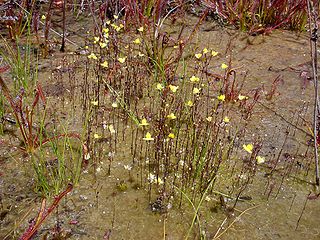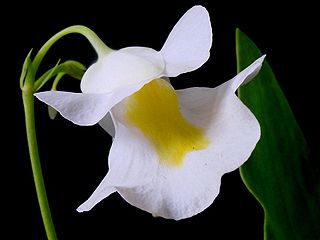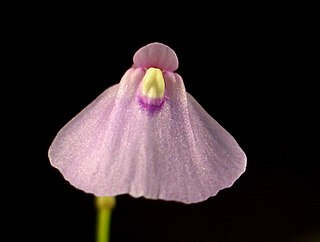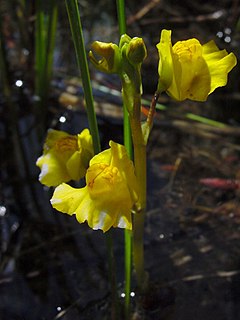Utricularia beaugleholei is a terrestrial carnivorous plant that belongs to the genus Utricularia. Its distribution ranges from southeastern South Australia through central and western Victoria into New South Wales, where it has been collected from the southern tablelands and southwest slopes.
Utricularia quinquedentata is an annual, terrestrial carnivorous plant that belongs to the genus Utricularia. Its distribution ranges across northern Australia from Western Australia to northern Queensland and south to Brisbane. It was first identified by Ferdinand von Mueller as possibly a new species or variety in the early 1890s, noting it as "U. albiflora or a closely allied species." Mueller labeled one herbarium sheet as Utricularia albiflora var. quinquedentata. Without a valid description, according to the rules of botanical nomenclature, however, the epithet quinquedentata was not recognized until Peter Taylor validly published the species in 1986.

Utricularia subulata, the zigzag bladderwort, is a small annual, terrestrial carnivorous plant that belongs to the genus Utricularia. It is the most widely distributed species in the genus, being almost pantropical.

Utricularia subg. Utricularia is a subgenus in the genus Utricularia.

Utricularia sect. Pleiochasia is a section in the genus Utricularia.

Utricularia subg. Polypompholyx is a subgenus in the genus Utricularia.

Utricularia sect. Utricularia is a section in the genus Utricularia. The species in this section are suspended or affixed aquatic carnivorous plants.

Utricularia aurea, the golden bladderwort, is a medium- to large-sized suspended aquatic carnivorous plant that belongs to the genus Utricularia. It is the most common and widespread suspended aquatic species in Asia. Its native distribution ranges from India to Japan and Australia.
Utricularia floridana, the Florida yellow bladderwort, is a large affixed aquatic carnivorous plant in the bladderwort genus within the bladderwort family). It is a perennial plant that is endemic to southeastern United States.

Utricularia inflata, commonly known as the swollen bladderwort, inflated bladderwort, or large floating bladderwort, is a large suspended aquatic carnivorous plant that belongs to the genus Utricularia. It is a perennial that is native to the southeastern coastal plains of the United States. It has often been confused with U. radiata, which is similar but smaller than U. inflata. Since 1980, U. inflata has been reported to exist in locations beyond its traditional range, such as the Adirondack Mountains in New York, southeastern Massachusetts, and in Washington State. Studies on the populations in the Adirondacks suggest that an introduction of U. inflata to a location where it naturalizes can lead to altered sediment chemistry by reducing the net primary productivity of native species. It is also listed by the state of Washington as a problematic species because of the dense mat-forming habit of this aquatic Utricularia. It is one of the few carnivorous plants that can be invasive.

Utricularia intermedia, the flatleaf bladderwort or intermediate bladderwort is a small, perennial carnivorous plant that belongs to the genus Utricularia. It is usually found affixed to the substrate but it can also survive suspended in a body of water. U. intermedia is a circumboreal species and is found in North America, Asia, and Europe.

Utricularia radiata, the little floating bladderwort, is a medium-sized suspended aquatic carnivorous plant that belongs to the genus Utricularia. U. radiata is endemic to North America.

Utricularia stellaris is a medium to large sized suspended aquatic carnivorous plant that belongs to the genus Utricularia. U. stellaris is native to Africa, tropical Asia, and northern Australia.

Utricularia subg. Bivalvaria is a subgenus in the genus Utricularia. It was originally described by Wilhelm Sulpiz Kurz in 1874. In Peter Taylor's 1989 monograph on the genus, he reduced the subgenus to synonym under section Oligocista, a decision that was later reversed in the light of molecular phylogenetic studies and the subgenus was restored.

Utricularia cornuta, the horned bladderwort, is a small to medium-sized, probably perennial carnivorous plant that belongs to the genus Utricularia. U. cornuta is endemic to North America and can be found in the Bahamas, Cuba, Canada, and the United States. It grows as a terrestrial or subaquatic plant in marshes, swamps, and pools in shallow waters, mostly at lower altitudes. It was originally described and published by André Michaux in 1803.

Utricularia sect. Oligocista is the largest section in the genus Utricularia. The 42 species in this section are small to medium-sized terrestrial carnivorous plants native throughout the tropics, with six species in the Americas, ten in Africa, five in Australia, and the remainder in Asia, with 17 mostly native to peninsular India. Alphonse Pyrame de Candolle originally described and published this section in 1844. Peter Taylor published his taxonomic monograph of Utricularia in 1986, in which he placed this section within subgenus Utricularia. More recent phylogenetic data and revisions have reinstated subgenus Bivalvaria and have placed this section within it.

Utricularia involvens is a medium-sized, probably perennial, carnivorous plant that belongs to the genus Utricularia. It grows naturally in southeastern Asia and northern Australia. U. involvens grows as a terrestrial plant in wet grasslands or open vegetation, usually at low altitudes but ascending to 900 m (2,953 ft) in Malaysia. It was originally described and published by Henry Nicholas Ridley in 1895.
Utricularia odorata is a medium-sized, probably perennial carnivorous plant that belongs to the genus Utricularia. It is native to southeastern Asia and northern Australia. U. odorata grows as a terrestrial plant in wet grasslands at low altitudes. It was originally described by François Pellegrin in 1920. The specific epithet odorata is derived from reports that the flowers are fragrant.
Utricularia sect. Phyllaria is a section in the genus Utricularia. The sixteen species in this section are small or very small lithophytic or epiphytic carnivorous plants native to the mountains of Asia, ranging from India to China and New Guinea. One species, Utricularia striatula, is an exception and is widespread in much of the Old World tropics. Wilhelm Sulpiz Kurz originally described and published this section as Utricularia subg. Phyllaria in 1874. Franciszek Kamieński reviewed the genus in 1891 and reduced Kunz's subgenus to a section. Later botanists, including Peter Taylor, agreed with Kamieński's assessment. In Taylor's 1986 revision of the genus, he placed this section in subgenus Utricularia. Later molecular data resulted in the revision of Taylor's treatment, reinstating subgenus Bivalvaria and placing this section within it.
Utricularia salwinensis is a small, probably perennial, carnivorous plant that belongs to the genus Utricularia. It is endemic to China and is only known from the type location in northwestern Yunnan and two other collections in southeastern Xizang (Tibet). U. salwinensis grows as a lithophyte or terrestrial plant among mosses on wet cliffs or in bogs at altitudes from 3,275 m (10,745 ft) to 4,000 m (13,123 ft). It was originally described by Heinrich Handel-Mazzetti in 1936.













